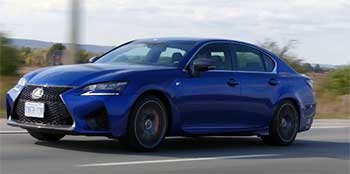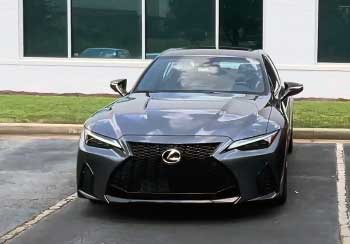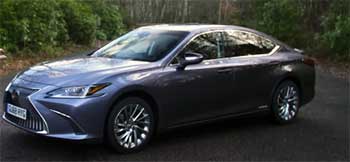I’ve always been drawn to the sleek elegance of Lexus sedans, each promising a blend of luxury, performance, and reliability. My goal here is to share my firsthand experience with the Lexus GS, IS, and ES, breaking down their strengths and weaknesses to help you decide which one fits your driving style. Through a detailed comparison, I’ll explore their features, performance, and comfort, offering a clear picture of what each model brings to the table. Whether you’re after sporty thrills or plush comfort, this article will guide your choice.
Comparison Table of Lexus GS vs Lexus IS vs Lexus ES
| Feature | Lexus GS (2020) | Lexus IS (2024) | Lexus ES (2024) |
| Starting MSRP | $51,065 | $40,085 | $41,860 |
| Drivetrain | RWD, AWD available | RWD, AWD available | FWD, AWD available |
| Engine Options | 3.5L V6 (311 hp) | 2.0L I4 (241 hp), 3.5L V6 (311 hp), 5.0L V8 (472 hp) | 2.5L I4 Hybrid (215 hp), 3.5L V6 (302 hp) |
| Fuel Economy (City/Hwy) | 19/28 mpg | 21/31 mpg (I4), 19/28 mpg (V6) | 22/32 mpg (V6), 43/44 mpg (Hybrid) |
| Cargo Space | 18.4 cu ft | 10.8 cu ft | 13.9 cu ft |
| Passenger Volume | 99 cu ft | 90.2 cu ft | 99.9 cu ft |
| Wheelbase | 112.2 in | 110.2 in | 113 in |
| Length | 192.1 in | 185.4 in | 195.9 in |
| Safety Rating | Not fully tested by IIHS | IIHS Top Safety Pick | IIHS Top Safety Pick+ |
| Key Features | Sporty handling, premium interior, V8 option (GS F) | Agile dynamics, F SPORT package, compact size | Smooth ride, hybrid option, spacious cabin |
My Journey with Luxury Sedans
Growing up, I was fascinated by the automotive world, particularly luxury sedans that promised both comfort and excitement. Lexus, with its reputation for blending Japanese precision with opulent design, always caught my eye. I’ve spent countless hours behind the wheel of various models, from test drives to long-term rentals, and I’ve come to appreciate the nuances that set each sedan apart.
The Lexus GS, IS, and ES represent different flavors of luxury, each catering to a unique driver. My experiences in the industry, from car shows to conversations with fellow enthusiasts, have shaped this comparison. I’m here to share what it’s like to live with these sedans, focusing on their real-world performance, comfort, and value, so you can find the one that resonates with your lifestyle.
Lexus GS Overview

The Lexus GS, discontinued after 2020, was the sporty middle child of the Lexus sedan lineup.
I remember sliding into the driver’s seat of a 2020 GS 350 F Sport. Its bolstered seats hugged me as I gripped the leather-wrapped steering wheel.
The GS was built on a rear-wheel-drive platform, with all-wheel drive as an option. This gave it a dynamic edge that appealed to enthusiasts like me.
Lexus GS Pros
- Sporty Handling: The GS, especially in F Sport trim, felt planted and responsive. It has sharp steering that made twisty roads a joy.
- Powerful Engine Options: The GS F’s 5.0L V8, pumping out 467 horsepower, was a rare treat in this class. It delivered thrilling acceleration.
- Spacious Trunk: With 18.4 cubic feet of cargo space, I could easily fit golf bags or luggage for a weekend getaway.
- Premium Interior: The cabin exuded quality, with soft-touch materials and features like power thigh extensions that added comfort on long drives.
- Reliability: Lexus’s stellar reputation for durability gave me peace of mind, backed by a 6-year/70,000-mile powertrain warranty.
Lexus GS Cons
- Discontinued Model: Since production ended in 2020, finding a new GS is impossible. Used models may lack the latest tech.
- Dated Technology: The infotainment system, with its finicky touchpad, felt clunky compared to newer Lexus models.
- Fuel Economy: The V6’s 19/28 mpg wasn’t terrible, but it lagged behind competitors, especially hybrids.
- Limited Rear Legroom: At 36.8 inches, the rear seat felt cramped for taller passengers on extended trips.
- Higher Price Point: Starting at $51,065, the GS was pricier than its siblings. This could deter budget-conscious buyers.
Driving the GS was like dancing with a partner who knew all the moves but occasionally missed a step due to outdated tech. It was a car for those who craved performance with a touch of luxury. However, its discontinuation left a void for sport sedan enthusiasts.
Lexus IS Overview
The Lexus IS is the compact, agile contender in this trio. During a test drive of a 2024 IS 350 F Sport, I was struck by its nimble handling and bold styling. Its smaller footprint made it feel like an extension of my body, perfect for zipping through city streets or carving up backroads.

Lexus IS Pros
- Dynamic Performance: The IS 500’s 5.0L V8, with 472 horsepower, was a beast. Even the base 2.0L turbo offered peppy acceleration.
- Compact Size: At 185.4 inches long, it was easy to park and maneuver in tight spaces. This is a boon for urban drivers like me.
- Modern Tech: The updated infotainment system, with a touchscreen, was far more intuitive than the GS’s setup.
- F SPORT Appeal: The F Sport package added aggressive styling and a tuned suspension. This made every drive feel special.
- Affordable Entry: Starting at $40,085, the IS was the most budget-friendly option. It offered great value for a luxury sedan.
Lexus IS Cons
- Cramped Rear Seat: With only 32 inches of rear legroom, it wasn’t ideal for carrying adult passengers regularly.
- Small Trunk: The 10.8 cubic feet of cargo space felt limiting. It barely fit my weekly groceries.
- No Hybrid Option: Unlike the ES, the IS lacks a fuel-efficient hybrid. This was a drawback for my long commutes.
- Ride Firmness: The sporty suspension, while great for handling, made the ride feel harsh on rough roads.
- Less Luxurious Cabin: The interior, while nice, didn’t match the plushness of the GS or ES, especially in base trims.
The IS was my go-to for spirited drives. However, its compact nature meant sacrifices in space and comfort. It’s a car for those who prioritize driving dynamics over practicality.
Lexus ES Overview
The Lexus ES is the comfort king of this lineup. I spent a weekend with a 2024 ES 350, and its smooth ride and spacious cabin made it feel like a rolling sanctuary. Built on a front-wheel-drive platform (with AWD available), it’s closely related to the Toyota Camry but elevated with Lexus’s signature refinement.

Lexus ES Pros
- Silky Smooth Ride: The ES soaked up bumps effortlessly, making it ideal for long highway cruises.
- Spacious Interior: With 99.9 cubic feet of passenger volume and 39.2 inches of rear legroom, it was perfect for family or friends.
- Fuel Efficiency: The hybrid’s 43/44 mpg was a game-changer for my wallet, especially with rising gas prices.
- Advanced Safety: Earning an IIHS Top Safety Pick+ rating, the ES gave me confidence with features like adaptive cruise control.
- Lower Price: Starting at $41,860, it offered a compelling mix of luxury and affordability.
Lexus ES Cons
- Less Engaging Drive: The ES prioritized comfort over sportiness, feeling less dynamic than the GS or IS.
- FWD Bias: Even with AWD, the front-wheel-drive roots made it less thrilling on twisty roads.
- Conservative Styling: The design, while elegant, didn’t turn heads like the IS’s bold lines or the GS’s muscular stance.
- Limited Engine Power: The 302-hp V6 was adequate but lacked the punch of the GS F or IS 500.
- Smaller Trunk: At 13.9 cubic feet, it offered less cargo space than the GS, which was noticeable on road trips.
The ES was my haven for relaxed drives, offering unmatched comfort and efficiency but lacking the excitement of its sportier siblings.
Performance Comparison
Performance is where these sedans diverge sharply. The GS, with its rear-wheel-drive setup and optional 467-hp V8 in the GS F, was a thrill machine. I recall flooring the GS F on an open highway. The V8’s roar pushed me back into the seat with a grin. The IS, particularly the IS 500, nearly matched that excitement with its 472-hp V8. However, even the base 241-hp turbo felt lively in city traffic. The ES, however, leaned toward efficiency. Its hybrid option sipped fuel. But the 302-hp V6 felt tame, better suited for smooth cruising than spirited sprints.
Handling was another differentiator. The GS’s track-honed suspension and precise steering made it a joy on winding roads, though it wasn’t as agile as the smaller IS. The IS’s compact size and F Sport tuning gave it an edge in tight corners, feeling like a sports car in sedan clothing. The ES, built on the Toyota New Global Architecture (TNGA), handled better than its predecessors. However, it still prioritized comfort, with a softer suspension that absorbed road imperfections but dulled driver engagement.
Interior and Comfort
Inside, each sedan told a different story. The GS’s cabin felt like a premium lounge. It had high-quality materials and features like power side bolsters that adjusted to my body during spirited drives. However, its dated infotainment system, with a touchpad that frustrated me during navigation, was a letdown. The IS’s interior was sporty but snug. It had LFA-inspired gauges that added flair but less overall refinement than the GS. The ES, meanwhile, offered a spacious, quiet cabin that felt like a step above. It had excellent climate control and plush seats that made long drives a breeze. Its touchscreen infotainment was a welcome upgrade. However, some controls felt carried over from older Lexus models.
Rear-seat comfort varied significantly. The ES’s 39.2 inches of legroom made it the clear winner for passengers, ideal for chauffeuring friends or family. The GS, with 36.8 inches, was decent but not outstanding. The IS’s cramped 32 inches made it less practical for regular backseat use. For families or those who frequently carry passengers, the ES was the standout.
Also Read: Lexus IS350 vs. Lexus IS500
Technology and Safety
Technology is a critical factor in modern luxury sedans, and each model had its strengths. The IS, being the newest, boasted a modern touchscreen infotainment system that was intuitive and responsive, a stark contrast to the GS’s clunky touchpad setup. The ES struck a balance, offering a touchscreen and a robust suite of standard features like navigation and a premium audio system. However, its interface felt slightly dated compared to the IS.
Safety-wise, the ES led the pack with its IIHS Top Safety Pick+ rating, thanks to superior crash test scores and advanced features like blind-spot monitoring and adaptive cruise control. The IS earned a Top Safety Pick rating, a strong showing but not quite as comprehensive. The GS, not fully tested by IIHS, still included similar safety tech but lacked the latest advancements found in its siblings.
Practicality and Efficiency
For daily usability, the ES shone with its spacious cabin and excellent fuel economy, especially in hybrid form. I calculated significant savings on fuel during a month-long test, making it ideal for commuters. The GS’s larger trunk was a boon for road trips, but its fuel economy lagged, and its higher price made it less practical for budget-conscious buyers. The IS, while fun to drive, was hampered by its small trunk and lack of a hybrid option, making it less versatile for long-term ownership.
Driving Experience
My drives in each sedan revealed their distinct personalities. The GS felt like a grand tourer, blending power and refinement for long, spirited journeys. The IS was a pocket rocket, perfect for quick jaunts and city adventures, though its firm ride could be tiring. The ES was the ultimate cruiser, smoothing out rough roads and keeping me relaxed, but it never sparked the same excitement as the others.
Value for Money
Price played a big role in my evaluation. The IS, starting at $40,085, offered the best value for those seeking sporty performance on a budget. The ES, at $41,860, was a close second, delivering more space and efficiency for a slight premium. The GS, at $51,065, felt overpriced for its dated tech, especially since it’s no longer in production. For used GS models, depreciation could make them a bargain, but I’d recommend checking maintenance history to avoid potential issues.
Choosing the Right Sedan for You
Your choice depends on your priorities. If you crave performance and don’t mind a snug cabin, the IS is your match.
Discover More: Lexus IS 350 vs. IS 500
Frequently Asked Questions
The ES is better for comfort, space, and fuel efficiency, especially with its hybrid option. The IS excels in sporty handling a
nd performance, ideal for driving enthusiasts. It depends on your priorities.
The IS is better for agile handling, modern tech, and affordability, while the GS offers more space and a refined ride. The GS is discontinued, so the IS is easier to find new.
Yes, the GS sits higher in the lineup with more premium features and a smoother ride.
Conclusion
After spending time with the Lexus GS, IS, and ES, I’ve seen how each sedan caters to a different driver. The GS thrilled me with its sporty edge, the IS kept me engaged with its agility, and the ES cocooned me in comfort. Your choice hinges on what you value most—performance, practicality, or a blend of both. I hope my experiences help you find the Lexus sedan that feels like home on the road. Take a test drive, feel the difference, and let your heart (and budget) guide you.

